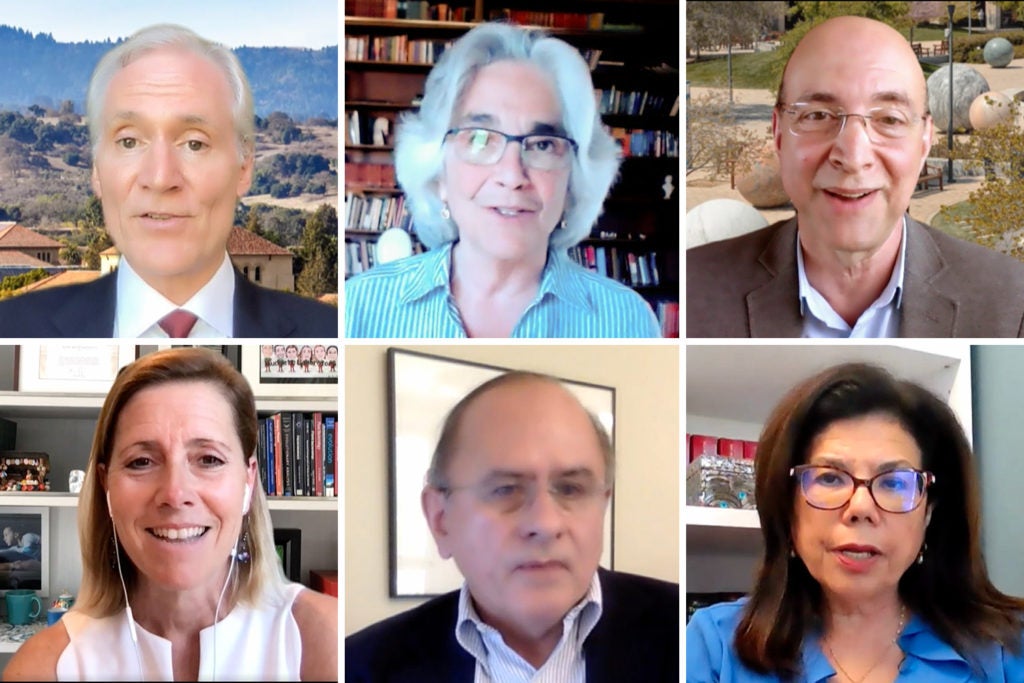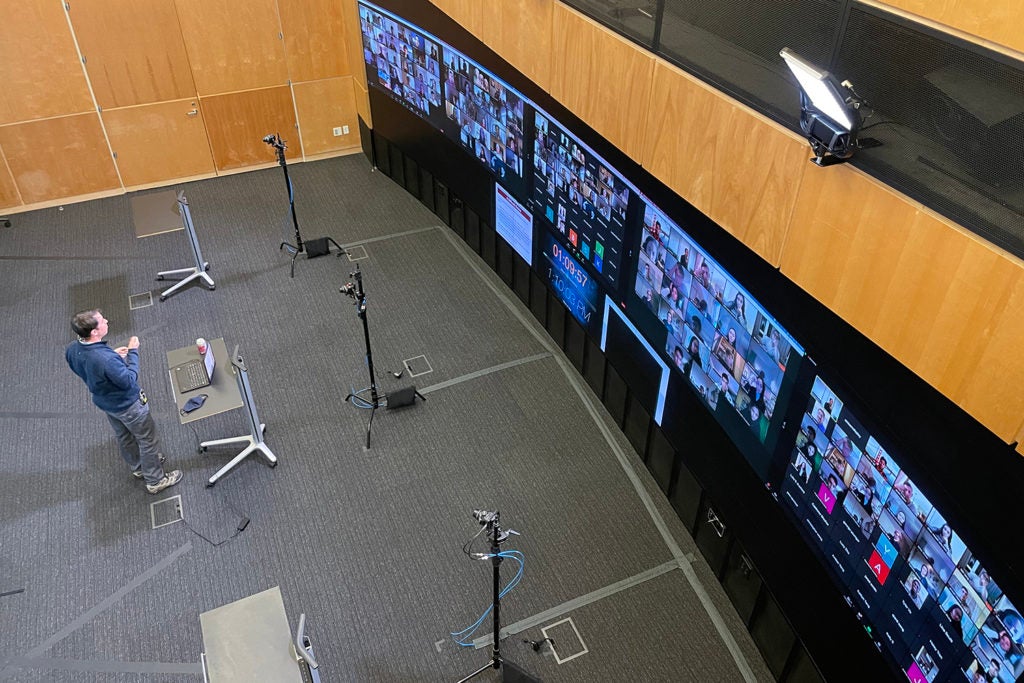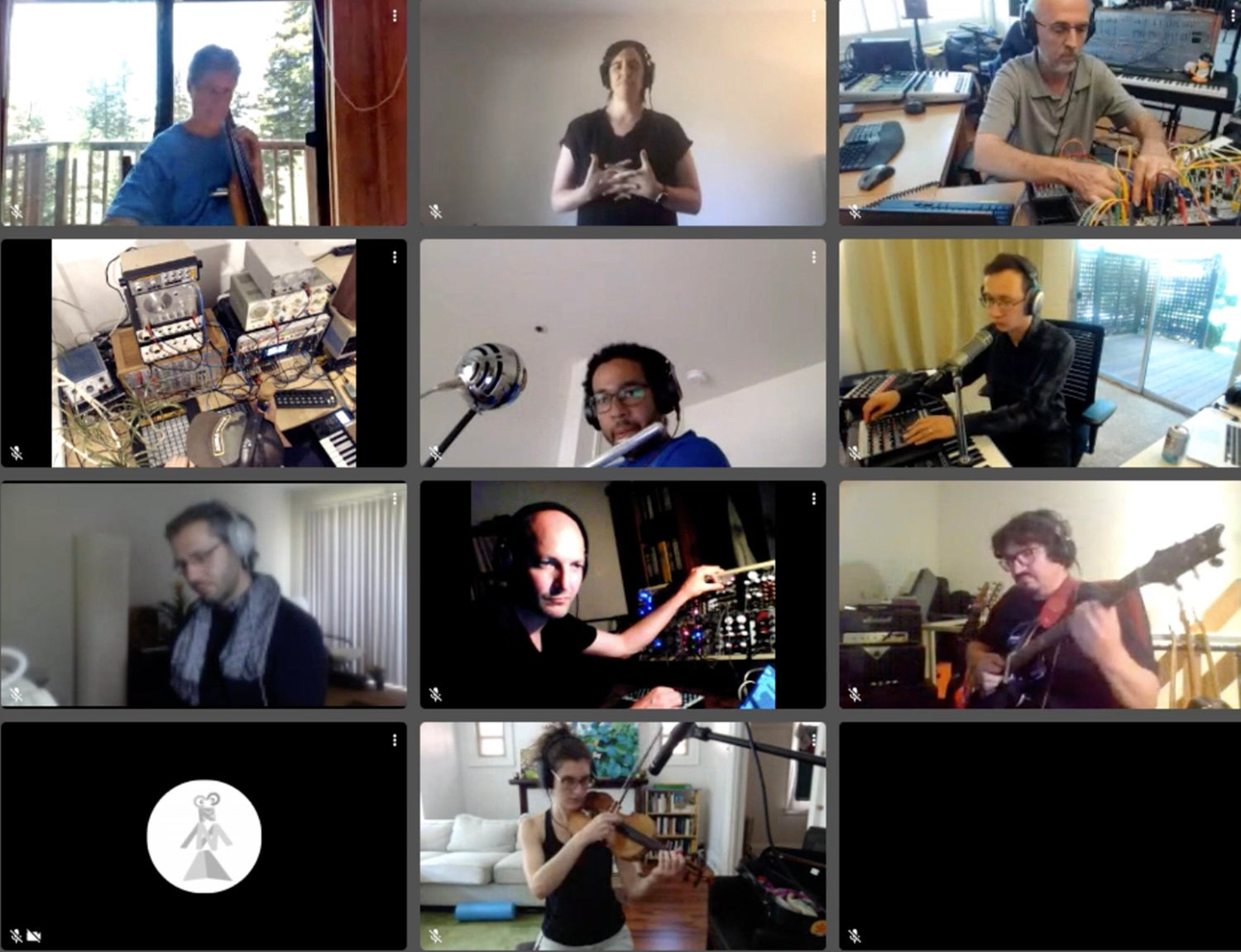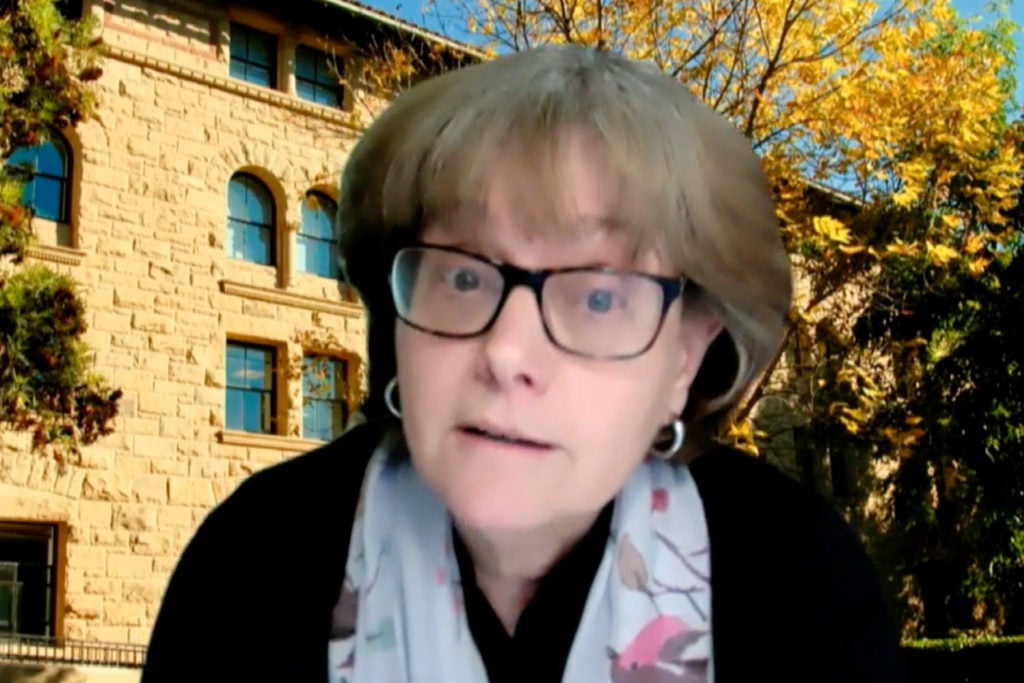Achievements honored, losses noted at annual gathering of Academic Council
In a presentation to the Academic Council, President Tessier-Lavigne summarized reasons for optimism post-pandemic, including progress made on the Long-Range Vision, the university’s improving financial position and the attributes of the campus community.
As challenging as the past academic year has been because of the pandemic, Stanford nevertheless recorded some eye-popping achievements.

From top left: Marc Tessier-Lavigne, Persis Drell, Tim Stearns, Mary Beth Mudgett, Matthew Snipp and Yvonne (Bonnie) A. Maldonado. (Image credit: Andrew Brodhead)
Take, for instance, 9,480 remote classes taught, $100 million achieved in funding for COVID research alone, 59 COVID-related inventions and 65,000 telemedicine visits per month.
What makes those numbers even more impressive, according to President Marc Tessier-Lavigne, is that they were achieved in a year in which access to campus facilities dropped precipitously and university operations had to be rebuilt from the ground up.
Tessier-Lavigne reported on those developments and others during the annual meeting of the Academic Council on Thursday. He cited reasons for optimism in the future, including progress made on the Long-Range Vision, the university’s improving financial position and the attributes of the campus community.
Tessier-Lavigne also noted that Stanford has expanded the reach of its research through online conferences and events during the pandemic. Many events, he noted, attracted more attendees than often came in person.
“In education in research, in the arts, in telehealth and in many other areas, the pandemic has shown us the potential to broaden our reach and improve access to many areas of our university,” he said. “These are opportunities we can continue to take advantage of and build on in the future.”
A hard year
But despite those accomplishments, Tessier-Lavigne somberly acknowledged, “It has been a hard year.”
And, unfortunately, the hardships are as sobering as the community’s achievements are impressive.
Many in the campus community have lost family and friends. Disparities in the effects of the pandemic highlighted persistent and painful inequities. Some students toiled at home with no place to study and insufficient access to the Internet. Faculty and staff with young children struggled with remote schooling and caregiving responsibilities. Female faculty and staff were especially affected. Pre-tenured faculty lost research time and funding opportunities.
The university offered assistance, ranging from an extended tenure clock to expanded leave time to financial support for students and families.
“Such measures help,” Tessier-Lavigne said. But, he added, “They don’t fully reverse the effects of the pandemic. And there’s no denying that this level of stress takes a toll and that it has had a very real impact on members of our community.”
The pandemic also forced what Tessier-Lavigne called “tough and painful” decisions because of financial challenges. Those decisions, difficult as they were, have put the university on the right course for the future.
Reasons for optimism
Tessier-Lavigne pointed to progress made on the Long-Range Vision – what he called Stanford’s “north star” – and improvements in the university’s financial position as reasons for optimism. Coupled with five attributes that characterize the campus culture, Tessier-Lavigne said he believes the university will emerge stronger from the pandemic.
Among those attributes, he cited commitments to tackling the world’s greatest challenges, creating a learning environment that prepares students to be engaged citizens and purposeful leaders, making Stanford better, ensuring everyone’s voice is heard and being resilient and bold.
Those attributes were reflected in accomplishments the president highlighted, including:
- The creation of an early diagnostic test for COVID-19 by a team led by Benjamin Pinsky, associate professor of pathology and of medicine. Their problem-solving work, he said, “is Stanford at its best.”
- The foundation established for a new school focused on climate and sustainability.
- The creation of the Civic, Liberal and Global Education requirement – known as COLLEGE – which offers undergraduates, regardless of major, a forum to consider ethical and societal problems within a rigorous academic context.
- The implementation of Res-X, which creates neighborhoods that encourage community and promote well-being and personal growth among students.
- The community’s response to instances of racial injustice, and university initiatives such as the Community Board on Public Safety, the IDEAL Fellows program and the faculty cluster hire.
- Faculty Senate conversations about Stanford values and the meaning of academic freedom.
Tessier-Lavigne evoked the resilience of generations of Stanford faculty, staff and students, who endured such challenges as war, disease and natural disasters in the past.
“In the face of difficulty and hardship, they found solutions that have made our world better,” he said. “As we emerge from this dark time, with our boldness of spirit and with our Long-Range Vision to chart our course, I truly believe that our university’s best days are ahead.”
Although trying, Tessier-Lavigne noted the pandemic has given the campus community a “deep and first-hand knowledge of what it feels like to support one another through hard times, and we have been reminded of how much we cherish and are enriched by each other’s company, in person.”
A year of accomplishments
Points made by the president were expanded by members of a faculty panel organized by Provost Persis Drell and focused on accomplishments during the year. Panel members were:
- Yvonne “Bonnie” Maldonado, senior associate dean for faculty development and diversity and the Taube Professor of Global Health and Infectious Diseases and professor of pediatrics.
- Mary Beth Mudgett, senior associate dean for Undergraduate Education Initiatives and professor of biology.
- Matthew Snipp, vice provost for Faculty Development, Diversity and Engagement and the Burnet C. and Mildred Finley Wohlford Professor in the School of Humanities and Sciences.
- Tim Stearns, the Frank Lee and Carol Hall Professor and senior associate vice provost of research and professor of genetics.
Among the accomplishments cited by Maldonado was the rapid response from the beginning of the pandemic by Stanford Medicine, Stanford Health Care and Stanford Children’s Health. Health care workers and researchers confronted the pandemic in real-time, despite uncertainties about its transmission, virulence, pathogenesis, treatment and interventions.
As of the beginning of May, Maldonado said Stanford Medicine has administered 346,639 doses of vaccine in locations ranging from the Cisco garage in San Jose to the Pleasanton Fairgrounds to the Aloha Roller Rink in East San Jose.
“Even though there were so many unknowns, our community members never stopped working,” Maldonado said. “As the weeks and then months wore on, plans were upended and a series of grim firsts piled up – the first virtual Match Day when our Stanford medical students found out where they would be starting their residency training, first virtual graduations, first day of remote learning, as well as class learning, and first birthdays away from loved ones.”
Other firsts, however, were causes for celebration. For instance, the outpatient COVID Clinical Treatment Research Unit was one of the first and most active in the nation in identifying novel therapeutics and enrolling COVID-19 patients in trials to identify promising treatments. Trials that contributed to the authorization of remdesivir were quickly launched, as were population-based epidemiologic studies that helped scientists understand the natural history of COVID-19.
Stanford has been one of only a handful of academic medical centers in the United States with robust outpatient clinical trials, especially of antiviral therapies.
Maldonado praised the efforts of Stanford Medicine in providing guidance to public officials at the local, state, federal and global levels through the Recover, Restore and Re-open program available on the Stanford Medicine website.
Moving forward, she noted future challenges, including studying further the inequities COVID-19 revealed.
Academic continuity
Mudgett, who co-chairs the Academic Continuity group, credited instructional teams, teaching support teams and departments and programs across the seven schools with enabling the university to achieve academic continuity despite the pandemic.

Among the technological innovations of the past year was a new Zoom-based platform with multiple screens and mics that offers the benefits of a large lecture class, while leveraging small breakouts to develop a sense of community. (Image credit: Bob Smith)
Cumulatively, their work meant the university could maintain most of its course offerings, allowing students to stay on track. She singled out staff at the Center for Teaching and Learning (CTL), the Learning Technology & Spaces and University IT for their work in enabling the university to pivot to online learning.
Among the notable resources made available to instructors during the pandemic were the web portal Teaching Commons; CTL’s expanded services for course design, pedagogy and educational technology; the Stanford TEACH symposia; and the Teach Anywhere site.
Remote learning led to innovative methods of engaging students worldwide. Mudgett cited creative use of course kits, the use of new technology to enhance group activities and build community and leadership by teaching assistants.
Among the innovations she cited were:
- At-home lab kits for Chemistry 31A and B that were key to making abstract concepts tangible. Similar course kits were developed for physics labs, engineering and design courses, art practice and music.
- A collaboration in Winter 2021 between CTL and instructors from CS 182 supported a large, team-taught course. Using Wallenberg Learning Theatre and a new Zoom-based platform with multiple screens and mics, the team maintained the benefits of a large lecture class, while leveraging small breakouts to develop a sense of community.
- Computer Science reimagined Code in Place, a popular course worldwide that engaged more than 10,000 students in 120 countries with the partnership of 900 volunteer experts in the field. This example of “human-centered learning” shows how Stanford’s educational mission can be adapted to educate global citizens.
- In the humanities, Stanford musicians leveraged the use of JackTrip software for real-time sound streaming online for orchestra performances and music courses.

Screengrab of a JackTrip-powered music performance. (Image credit: Chris Chafe)
Despite those accomplishments, Mudgett noted challenges as well such as:
- inequities among students engaging in online instruction,
- heightened tensions surrounding course policies and accommodations,
- a spike in honor code violations with online assessments,
- and overall fatigue, both physical and mental.
Looking forward, Mudgett anticipates a return to a normal, 10-week quarters academic calendar featuring in-person course instruction. But she also anticipates instructors integrating online innovations into their teaching to improve student learning.
Faculty diversity progress
Progress was also made in efforts to advance university scholarship about race and ethnicity and adding to faculty diversity, according to Snipp.
Launched in the fall of 2020, the IDEAL Provostial Fellows Program attracted 652 applicants. Five of an eventual 15 fellows in three cohorts were given three-year appointments.
Under the Faculty Cluster Hire, some 10 billets will be filled with scholars who specialize in race and ethnicity, six in the social sciences and humanities and four in STEM fields. Much of the work in non-STEM searches has been completed, with six offers made so far. Work continues in STEM searches.
Snipp provided updates on the Framework Task Force, which has recommended the creation of a Department of African and African American Studies and continues to consider how the university should best organize education and research on race and ethnicity. At this point, he said the task force is moving toward a two-fold vision of scholarship, engaging the Stanford community and engaging the world beyond Stanford.
Among the upshots of the cumulative work in this area, Snipp said Stanford will welcome the most diverse cohort of new faculty in the university’s history in academic year 2021-22.
Research funding increase
Stearns described the profound effect the pandemic has had on research, initially forcing a shutdown of most operations, followed by minimum basic operations with only one or two people per lab and then slowly expanding. Now plans are in place to increase research access during the summer, resulting in a “more normal” fall.
Stearns said he hopes that everyone who wants to come back to campus to do research will be able to in the fall, although he noted the unpredictability of the pandemic.
Early in the pandemic, Stearns said the university approved research projects on critical short-term needs, improved diagnostics, development of therapies and increasing understanding of how the SARS-CoV-2 virus works to infect cells.
Some $2.5 million was awarded through the Stanford RISE program for projects that creatively addressed issues raised by the pandemic. He cited the creative project in the arts and humanities called “Recovery,” which was funded through The Changing Human Experience program.
Despite research challenges, Stearns said new award funding has grown by almost 10 percent across the campus, with that amount higher in the School of Medicine, where the increase is primarily due to COVID-19-related research.
Faculty Senate report
Accomplishments achieved despite the pandemic were also highlighted in a report of the Faculty Senate’s year by Judith Goldstein, chair of the Faculty Senate and the Janet M. Peck Professor of International Communication.

Chair of the Faculty Senate Judith Goldstein provided a report of the senate’s year during Thursday’s Academic Council meeting. (Image credit: Andrew Brodhead)
Calling the past year “most unusual,” Goldstein noted that senators met only online and never in person. Despite that loss of community, she noted that the senate’s 16 meetings were likely more efficient than previous in-person gatherings.
Among the thorny issues tackled by the senate were the rights and responsibilities of academic freedom, especially as it applied to positions advocated by Hoover fellow Scott Atlas when he served in the Trump administration. Also debated was the relationship of the Hoover Institution and Stanford.
“These were both difficult issues, and the faculty did not speak with one voice,” Goldstein said, adding, “Debate expanded beyond these cases to some of the most fundamental issues for all universities: the meaning of academic freedom, the limits of freedom of expression and consideration of just what were the rights and responsibilities of members of the Academic Council and of the university administration.”
Goldstein summarized other actions by the Faculty Senate:
- Adjudicated and found a compromise on the unit cap on majors and a resolution on sustainability.
- Approved a recommendation by the Committee on Libraries to create an open access repository.
- Debated issues relating to students, including making Election Day an academic holiday, revision of the honor code and admissions criteria.
- Heard updates on the new school of sustainability.
- Received numerous reports about COVID-19.
- Discussed faculty quality of life survey results with the Faculty Women’s Forum.
- Heard about the changing nature of athletics.
- Agreed to revise the statement on faculty discipline.
Goldstein acknowledged that many of the issues were contentious, but she credited Faculty Senate members for debating with respect and attempting to find consensus.
“The senate at Stanford is unique, and here, the history of faculty governance runs deep,” she said. “The senate is the one place that the faculty is asked to engage as a community, and although we don’t always get everything right, I would urge all members of the Academic Council to actively participate. The university needs more speech, not less. We need more participation, not less.”
Other actions
Prior to the Academic Council meeting, the Administrative Session of the Steering Committee met. Among the actions taken:
- Approved the Committee for the Review of Undergraduate Majors’ recommendations for approval of the degree-nominating authority for the BA degree, undergraduate Minor and Honors program in the Interdisciplinary Program of Archaeology, for a five-year renewal period from Sept. 1, 2021, through Aug. 31, 2026.
- Approved the Committee on Review of Undergraduate Majors’ recommendation of a five-year renewal for the Interdisciplinary Feminist, Gender and Sexuality Studies degree for the period Sept. 1, 2022, through Aug. 31, 2027.
- Approved the Committee on Review of Undergraduate Majors recommendations for a four-year renewal for the Interdisciplinary Honors Program in the Arts with authority to nominate candidates for the Interdisciplinary Honors degree for the period Sept. 1, 2021, through Aug. 31, 2025.
- Approved the Committee for the Review of Undergraduate Majors’ recommendation for approval of the degree-nominating authority for the BA degree, undergraduate Minor and Undergraduate Honors program in the Interdisciplinary Program of Urban Studies for an eight-year period from Sept. 1, 2022, through Aug. 31, 2030.
- Approved the Committee on Review of Undergraduate Majors’ recommendation for a five-year renewal for the Interdisciplinary Program in Science, Technology and Society with authority to nominate candidates for the degree for the period Sept. 1, 2022, through Aug. 31, 2027.
- Postponed consideration of a recommendation by the Committee on Review of Undergraduate Majors for a five-year renewal for the Interdisciplinary Program in African and African American Studies with authority to nominate candidates for the undergraduate major (BA), minor and honors for the period of Sept. 1, 2021, through Aug. 31, 2026.